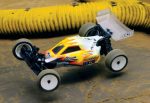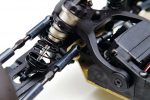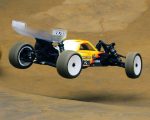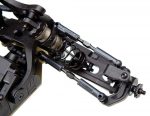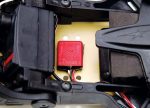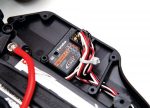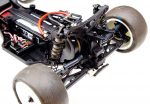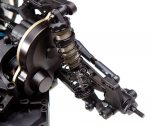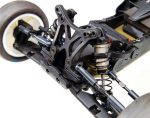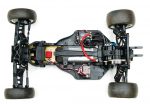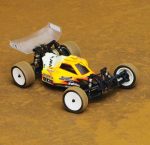A proven track performer just got better!
When considering the recent trends in 2WD buggy,mid motor setups are definitely the hot ticket. The current high bite tracks demand the weight distribution and balance of such a design, but what if you want to run in some real dirt… i.e., throwing roosts and all? The answer is usually to buy a new car or conversion kit. Team Durango, however, has got your back. They were the first to release a mass produced, kit version 2WD buggy that included all the necessary parts to run it as either a mid or rear motor car. This DEX210 V3 is no different, but it is better. The overall layout and design of the DEX210 hasn’t changed much, but small revisions have led to the three versions released to date. This latest buggy, the V3, packs all of the winning heritage from the earlier versions into a potent platform with race-inspired components to get you onto the podium quickly. Whether your track is carpet or turf, clay or loamy dirt, the 210 V3 can be set up accordingly to get you in the winner’s circle without spending a small fortune doing it. Top it all off with excellent support from Hobbico and you’ve got a sure thing in this new offering from Team Durango.
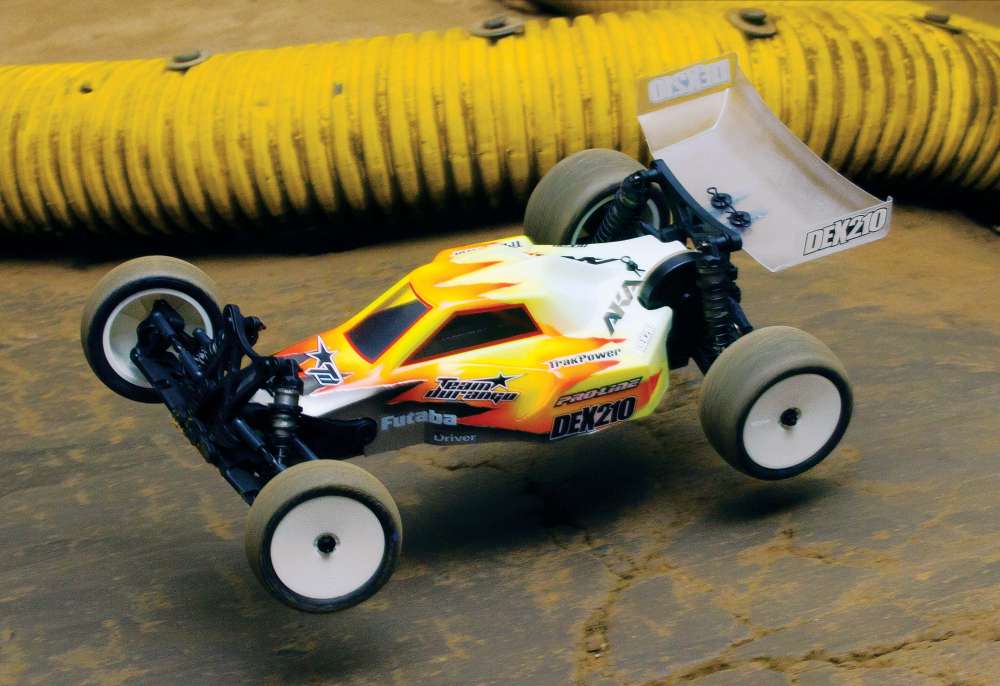
Photos: Edwin Rodriguez
AT A GLANCE
WHO MAKES IT: Team Durango
WHO IT’S FOR: Racers
PART NUMBER: TD102042
HOW MUCH: $249.99
BUILD TYPE: Kit
PROS
• Mid or rear motor mount
• New Multi-Axle drive shafts
• Tuning options everywhere
• New 12mm hex hubs
CONS
• Slipper assembly could prove tricky for first timers
• Droop screws are tough to get to
REVIEWER’S OPINION
I had the honor of reviewing the DEX210 V2 last year and while I thought that Team Durango really couldn’t improve on the platform … I was wrong. The one major issue with the 210s has always been the odd wheel hex and bearings which are not compatible with any other brands. Not any more. This new V3 model utilizes 12mm hexes front and rear with Orings capturing that ever elusive drive pin. The new “Multi-Shaft” axles are genius and they work as advertised while the super smooth big bore shocks make the V3 feel like racing on a cloud. Top it all off with a sleek new body with understated dorsal fin and a killer paint job by the man at the helm of RC Driver, Greg V, and you’ve got a track beast that’s dressed like a daydream.
TOOLS AND ACCESSORIES INCLUDED
• Durango includes only a turnbuckle wrench for tools, but there are plenty of spares. Don’t, by any means, get worried when you have parts left over. Remember, this kit can be built as a mid or rear motor with a 3 or 4-gear
tranny and all the parts to do so are in one box. Additionally, all the parts for the 12mm or 14mm axles are present, so once you follow the instructions to build your model in one fashion or another, you’re going to have a stack of parts left over.
ITEMS NEEDED
• 2-channel radio system
• High torque steering servo
• Brushless Motor and ESC
• 2S LiPo stick, shorty or saddle pack
• 2.2 front and rear tires and rims if using the 12mm hexes
• Building tools and shock oils
ITEMS USED
• TrakPower 17.5 Racing System (TKPC6045) $259.99 17.5 buggy racing has undoubtedly been the biggest class over the past year or two and this system from TrakPower can keep up with the best of ‘em. It features almost all the tuning options of a higher end unit, it is easy to program and it has a blinky mode for those stingy club directors or regional/national tech inspections. TrakPower also sells an MS Connect USB programmer for all those racers that want to tweak the ultimate setup, but it is not necessary for basic programming.
• Futaba BLS571SV S.Bus2 LP HV Servo (BLS571SV) $159.99 The 571 might not be the fastest or strongest servo out there, but it’s perfect for the DEX210 V3. Features such as the low profile build, brushless motor and metal gears are sure to keep it crankin’ without any maintenance for a good long while. That translates directly to more time on the track. Since it’s also an S.Bus servo, it is also fully programmable using the optional CIU-2 USB Interface.
• TrakPower 2S 4500mAh 90C Short LiPo (TKPC0610) $69.99 TrakPower is quickly becoming the go-to source for powering any and all of our surface models and this buggy is no different. Even though we could fit a full length stick pack in the 210 V3 in either motor configuration, this shorty pack gives us yet another tuning option. Given its short length, it can be shifted fore or aft to achieve whatever CG suits your needs. Not only that, but with a 90C discharge rating, it’ll pull for a solid eight minutes easily.
ADDITIONAL ITEMS USED
• Pro-Line Prime M4 2.2 Buggy Rear Tire (8241-03) $20.76 per pair
• Pro-Line Prime M4 2.2 Buggy Front Tire (8242-03) $19.16 per pair
• Futaba R614FF-E 4-Channel FASST Receiver (FUTL7632) $99.99
• AKA HEXlite 1/10 Buggy Wheels F/R (23202W, 23101W) $5.39, $5.49
• Team Associated Silicone Shock Fluid 30wt, 40wt (5422, 5423) $3.39 each
HOP-UPS WE RECOMMEND
• Team Durango Big Bore Shock Spring 45mm Set (TD230027) $32.99
• Team Durango Big Bore Shock Spring 65mm Set (TD230028) $32.99 To custom tailor your DEX210 to your style on any given track, pick up these sets of shock springs for infinite combos between the front and rear. With eight pairs per set, you get each pair of springs at a smidge over four dollars, but that value is instantly multiplied the minute you start traveling from track to track or venture onto different surfaces.
• Team Durango Big Bore Aluminum Shock Cap Set (TD230034) $22.99 per pair The big bore shocks on the DEX210 V3 are a thing of beauty. Threaded bodies with smooth double ring sealed bottoms and bleeder caps. Plastic bleeder caps. Grab up a couple pairs of these anodized caps to not only add a little bling to your buggy, but also ensure your suspension stays together through those rough mains. There’s no need to sacrifice a podium finish for a blown shock cap! Durango offers these alloy caps in black or their signature olive drab.
FEATURE BREAKDOWN
The standout feature of the new 210 V3 has got to be the “Multi-Axle” drive shafts. Wait…whuh? I’m not going to bust out the Pythagorean Theorem, but here’s the short version. By changing the length of the actual shaft, you can alter the on-power steering response. The new stub axles have inner and outer holes to accommodate for either of the included 62.5mm or 65mm shafts. We opted for the 65mm shafts to gain more exit steering while on the throttle as we were also running three degrees of toe in the rear. Hopefully the added authority up front would keep the rear of the car from “squaring up”.
From day one, the idea behind the original DEX210 was to offer options right out of the box. This latest incarnation of the proven platform is no different. If you’re running on loose, old-school type surfaces, run it in rear motor to get the weight where you need it. Does your club normally run on carpet or some other high-bite surface? Then the mid-motor setup is the way to go. Once you’ve decided on that, you can choose how to set up your suspension around the
location of the motor and based on your track surface.
Over the years, the one caveat, if you will, to owning and racing a DEX210 was that they ran oddball wheel hexes and bearings. Unless you had a fellow racer running the same 14mm rears and 5x10x4mm fronts to borrow a set of shoes from, you were stuck with what you had. This new 210 V3 kit now has 12mm hexes for the front and rear (don’t worry, Team Durango still includes all the parts to run 14mm rears if you have piles of those rims in your shop). The hexes are all low profile to keep the rotating mass down and utilize an oring in a recess around the edge to keep the pin from wandering. With 12mm hexes front and rear, the options for tires and wheels (both new and old) are aplenty.
One of the best parts about owning a Durango is its versatility. Midmotor, rear motor, camber, anti-squat, droop, castor … you name it, the DEX210 can do it and do it well. Mind you, that’s only with what comes out of the box. Gear diff aficionados (from earlier 210 releases) can drop the bevel gear diff right into the case on this buggy. Additionally, nearly all of the alloy goodies for the V2 buggy will fit the V3. Basically, you can tweak and tune your DEX210 V3 to your heart’s content, no matter what surface you might be racing on.

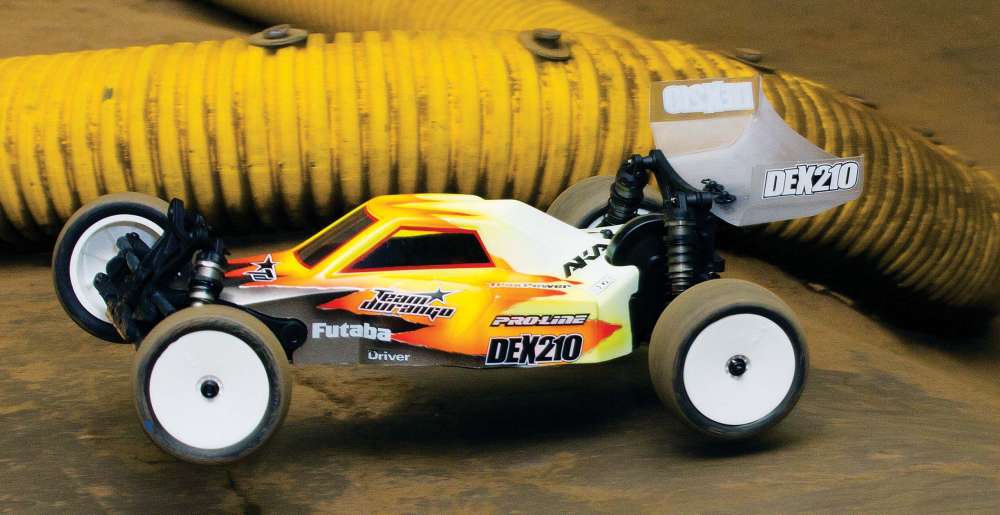
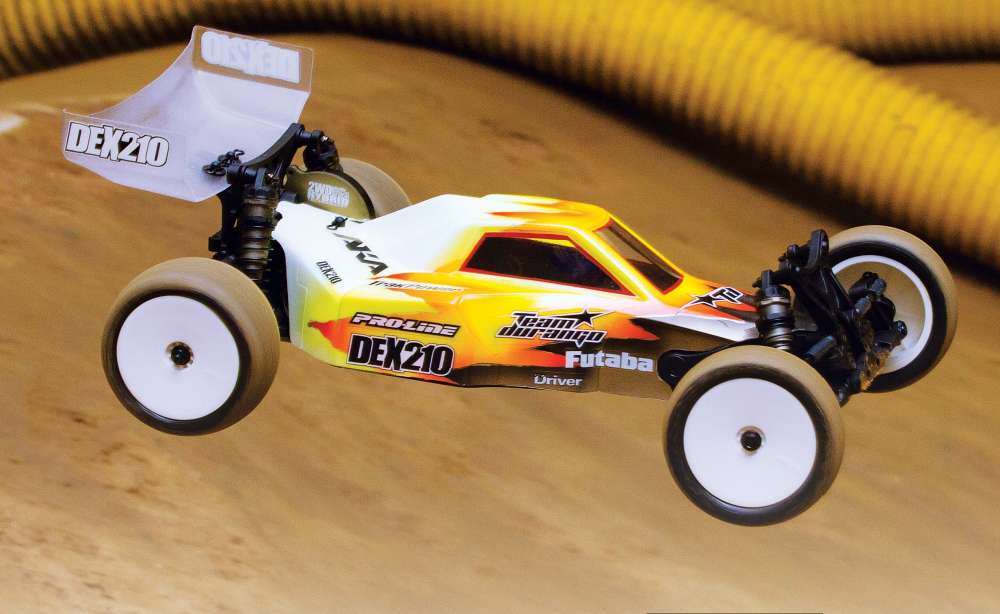
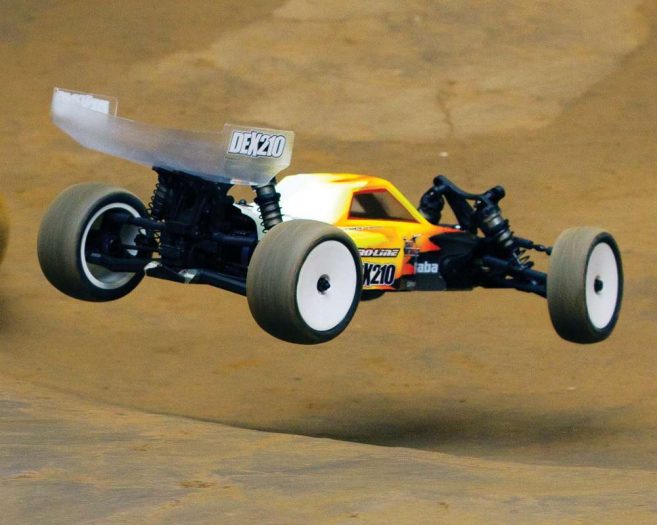
ON THE TRACK
STEERING
The steering in our DEX210 V3 buggy was excellent throughout testing. Our initial runs were conducted on a hard packed dirt track, running M4 Primes and while the three degrees of toe in the rear was fighting us through the on power sections of cornering, switching to the longer 65mm shafts all but eliminated any push. The Futaba servo swung the front tires around without so much as breaking a sweat and held it wherever we put it. On carpet and turf, the steering was too much, to say the least. Cranking the dual rates down to nearly 60 percent and dialing in a good deal of expo provided a much more predictable machine, but some further changes in the suspension could yield a far better setup. Though the included draglink offers two different positions for Ackermann adjustment, we felt no need to change it from the neutral setting, even on the tight indoor layouts.
ACCELERATION/BRAKING
The TrakPower MS-1 system provides excellent power and even though we set this 210 up for “Stock” class racing, we took the time to properly break the diff in, which proved to be well worth it. Once we had the tension set to our liking on the diff and slipper, the V3 buggy would launch out of the hole and corners. Running the three degree toe and anti squat block in the rear, the 210 showed little sign of lifting the front end up when the throttle was mashed. Initially, we started out using a 25 tooth pinion with the included 81 tooth spur, which is smack in the middle of the recommended gearing for the spur. However, the top end seemed a bit lacking on the longer straights, so a 29 tooth pinion was swapped in to keep the competitive edge. With this combo, the 210 V3 still had plenty of grunt on the low end, more than enough speed to keep up down the straight and the TrakPower motor remained comfortably warm. The braking had a smooth linear feel and it only took a couple of laps to find that “sweet spot” between too much brake and not enough to level the nose in flight.
HANDLING/JUMPING
With the new 12mm shocks and three hole pistons on all four corners, the DEX210 V3 was planted throughout all of our testing. Following along with the high-bite setup in the back of the manual, the 40wt oil up front and 30wt in the rear felt perfect on the well manicured surfaces with world class jumps. Even on the flat landings, the shocks kept the bottom from getting anywhere near the ground, so we cranked each droop screw down a half millimeter or so. This is a bit tedious as you have to remove one end of each front shock to get to the front droop screws and the left rear shock as well as the gear cover to get to the left rear droop screw. That being said, this process is still a heck of a lot easier than rebuilding each shock with limiters internally to set the travel. Now slammed on the deck, the V3 was able to carve some nice tight lines around the track with little to no chassis roll, predictably turning fast laps.
DURABILITY
Being seasoned racers, we normally don’t like putting a machine into the ring without a healthy supply of spares. This time though, we threw caution to the wind and signed up for a club race the day after the build was complete. Needless to say, after three messy qualifiers and a main that can only be described as mayhem (in addition to a good dozen subsequent test packs), our sturdy V3 mid-motor showed no ill affects from the abuse. The robust design of the shock towers and other suspension components lend themselves well to a hardy race platform. The composites used throughout the build are top notch and while the arms are described as composite plastic, they feel, taste and smell an awful lot like the graphite parts of yesteryear. The DEX210 might not be a featherweight compared to some other 2WD offerings, but it’ll likely still be running at the end of a hectic race when most others will be down for the count.
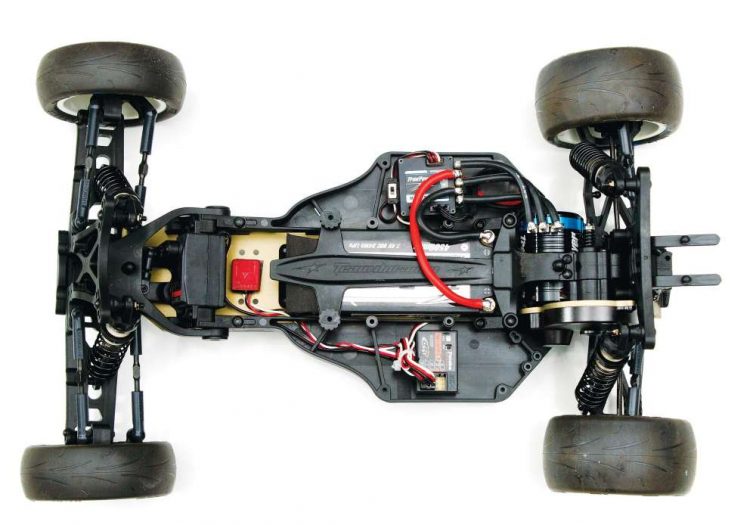
for in-depth reviews on the latest RC vehicles
SPECS AND TUNING OPTIONS
DIMENSIONS
LENGTH: 15.8 in. (400mm)
WIDTH: 9.8 in. (250mm)
WHEELBASE: 10.6 – 11.2 in. (274 – 282mm)
WEIGHT: 3.6 lbs. (approx)
BODY, WHEELS AND TIRES
BODY: Clear buggy body
WHEELS: Rear 14mm hex, front bearingstyle included
WHEEL ADAPTER TYPE: 12mm hex
TIRES: Not included
SUSPENSION
TYPE: 4-wheel independent
SHOCK POSITIONS: (F) 3-tower, 2-arm, (R) 5-tower, 3-arm
CAMBER: Fully adjustable links
ROLL: Adjustable shock tower mounts
WHEELBASE: Adjustable with spacers
RIDE HEIGHT: Droop screws front and rear
MISC: Varying rear toe/anti-squat blocks included
STEERING
TYPE: Bell crank with drag link
TOE: Fully adjustable links
CHASSIS
TYPE: Alloy center with composite side pods
MATERIAL: 6061 Aluminum
THICKNESS: 2.5mm
DRIVETRAIN
TYPE: 2WD
TRANSMISSION: 3 or 4-gear diff
DIFFERENTIAL: Ball diff
CLUTCH: Slipper
GEAR RATIO: 2.6
BEARINGS: Full set
RATING TALLY
Opinion: 9
Performance – Acceleration: 8
Performance – Steering: 8
Performance – Handling: 8
Performance – Durability: 8
Feature Breakdown: 9
Overall Value: 9
WRAP UP
I can honestly say that I didn’t think in a million years that Team Durango would revise their current platform rather than produce an entirely new machine. How could you improve on the V2? How? The 12mm hexes common to the masses of other buggies and innovations such as the new drive shafts and body are exactly what the DEX210 needed to not only keep up with the ever evolving crowd, but to set the pace. The DEX210 V3 is an excellent choice for those looking to get into racing as it is tough as nails, but it is also a proven winner, so seasoned pros looking for their next ride will rejoice in the tune-ability and performance of the V3. No matter who you are or where you race, the DEX210 V3 can be dressed to impress and it has more than enough brains and brawn to put you in front of the pack.
LINKS
Team Durango teamdurango.com
Hobbico hobbico.com
Futaba futabarc.com
Trakpower trakpowerusa.com
Pro-Line prolineracing.com
Aka raceaka.com
Team Associated teamassociated.com
 RC Driver The Best In RC Car & Truck News, Reviews & Video
RC Driver The Best In RC Car & Truck News, Reviews & Video 


